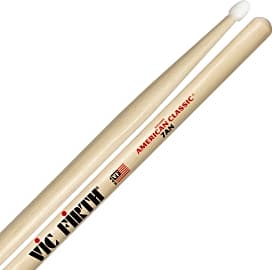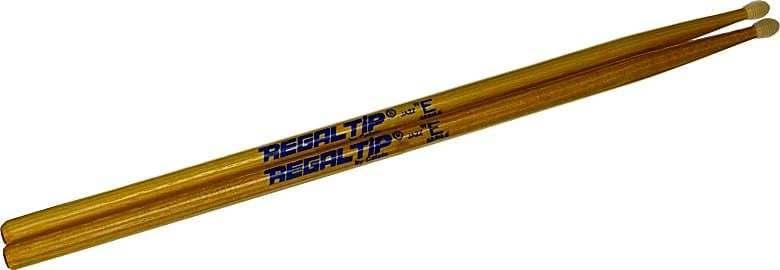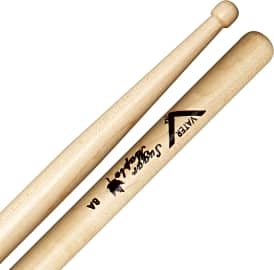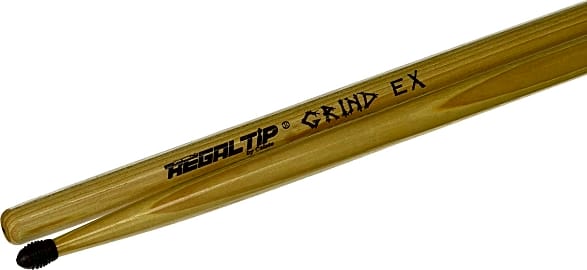The 10 Best Drumsticks

This wiki has been updated 36 times since it was first published in October of 2016. The right drumsticks can make a huge difference in sound and precision, and while they seem rather simple, there's a huge variety of models to choose from, often suited to very different playing styles. Including thick and loud options, slim designs offering exceptional control, and almost everything in between, here are some of the most highly regarded options on the market. When users buy our independently chosen editorial choices, we may earn commissions to help fund the Wiki.
Editor's Notes
April 20, 2019:
If you haven't yet had the chance to experiment with different sticks, you might be surprised at just how different one pair can be from the next. We consulted with a handful of drummers playing styles such as jazz, soul, R&B, blues, and metal, and found some of the most well-respected options around. Vater repeatedly got top mention from a number of rhythm players; they don't offer the largest variety of models, but one drummer we spoke to broke down how they are known among players to select only the highest-quality wood. Their Power 5A model is about as versatile as you'll find, and we haven't heard of nearly anyone who was unhappy with them. Vater's sugar maple 8A is a fantastic choice for jazz artists thanks to its sharp taper and especially light weight. Vic Firth is even more well-known among the general public, and you can't really go wrong with the 7A or 5A Blacks. If you're looking to outfit a snare drummer, Vic Firth's Corpsmaster is just about the thickest and strongest on the market. ProMark is also an intriguing brand with a lot of devoted followers; of particular note is their line of Japanese oak sticks, which are dense and solid and some of the most reliable around. Their FireGrain is another interesting option, thanks to their advanced strengthening treatment as well as remarkably attractive appearance. The ProMark select line is a rebound-balanced option that gives excellent feel during cross-stick play. Also, for every tree they use to make drumsticks, ProMark promises to plant an additional 5 trees. Finally, Regal Tip makes some of the most technologically advanced models. Their E-Series tips are made from nylon in a patented finned configuration, and pro players agree that they provide a near-perfect balance between the sterile, controlled sound of nylon and the warm, round tone of wood. Also of note is their unique finishing process the results in a lacquer that gets tackier as it gets warmed up, so even if you hands are slick from banging away under the bright lights for hours, you should never lose hold of them.
A Brief History Of Drums
Simply stretch some kind of membrane over a hole, and you have a drum.
Drums, or membranophones to use the technical term, may well be humankind's oldest instrument. Considering how simple they are to make, this isn't very surprising. Simply stretch some kind of membrane over a hole, and you have a drum.
Archaeologists have discovered Neolithic period drums made with alligator skins in China, which date to somewhere between 5500 and 3000 B.C.E. Excavations in the Mesopotamian region have also yielded small cylindrical-shaped drums that have been dated to roughly 3000 B.C.E.
Drums have served many purposes throughout history. For example, literary records show that drums were used in many ritualistic ceremonies, in addition to being used as musical instruments. They have also been utilized for a variety of militaristic reasons. As far back as the first millennium B.C.E., drums were used to boost troop morale and strike fear into the heart of the enemy. In fact, it is believed that at the Battle of Changshao between Qi and Lu in 684 B.C.E., drums provided enough of a moral boost to Lu's soldiers that they allowed them to completely change the tide of the battle and prove victorious. In addition, some cultures use drums to set a marching beat or convey messages to warriors in the heat of battle, alerting them when to press forward and when to retreat.
Surprisingly, humans aren't the only species to make use drums. Zoologists have observed macaque monkeys rhythmically drumming objects as a method of conveying social dominance. Research shows the macaque brain processes the sound of the drumming in a similar manner as it does vocal communications. Other primates and even some rodents have been observed making drumming sounds on their bodies or surrounding objects, as well.
How To Interpret The Drumstick Letter And Number System
We can thank the famed percussionist William F. Ludwig for creating the number and letter system used to identify drumsticks. This system is a way for manufacturers to tell drummers of the intended application for a particular pair of sticks, as well as inform them of the size. When creating the system, Ludwig chose three letters: A, B, and S, each of which corresponds to a certain genres of music. "A" sticks are generally the lightest in weight and smallest in diameter. These were intended for orchestra use and big-band type playing applications. Why Ludwig chose "A" instead of 'O" is unclear. The commonly held belief is that he just didn't like the way the letter "O" looked on the stick. "B" sticks are intended for symphonic and brass bands. They are usually heavier and thicker in diameter than "A" sticks, but still capable of producing soft sounds if needed. "S" on a pair of drumsticks stands for street. These are the heaviest and thickest of drumsticks, being intended for marching bands and drum corps.
This means that 7B sticks would be lighter in weight than 2B sticks.
Within each of these categories, we also have a number that denotes the weight of a stick. The main numbers are 2, 5, and 7, though many manufacturers these days also create custom drumsticks to suit the needs of their customers, so don't be surprised if you see some other numbers too. Counter-intuitive to what we may automatically assume, the higher the number, the lighter the weight of a stick. This means that 7B sticks would be lighter in weight than 2B sticks. On some sticks, you may also see an "N" after the first letter, such as 7AN. This final letter, if it is there, denotes that a pair of sticks has a nylon tip, instead of a wooden one.
Seven series sticks are generally intended for use in lighter-sounding genres, such as jazz or lounge music. 2 series sticks, being the heaviest, are ideal for hard-hitting metal and rock drummers. 5 series sticks are the most versatile of the three since they are neither the heaviest nor the lightest. They can be used to play nearly any genre, making them ideal for musicians who like to experiment with different kinds of music or those who often play different types of gigs. Because of this, 5 series sticks are the most commonly used around the world.
Choosing The Right Pair Of Drumsticks
Every drummer has a different playing style, meaning that each individual will prefer a different kind of drumstick. One of the first considerations is what kind of music you play the most, as this will make it easy to narrow down the field of potential options. Your body's physical features will also play a role in determining the best pair of sticks, such as your wrist strength, arm length, and the size of your hands.
Your body's physical features will also play a role in determining the best pair of sticks, such as your wrist strength, arm length, and the size of your hands.
If you are just getting into drumming and don't yet know what size and style of stick you prefer, we recommend you start with a pair of 5A sticks. As mentioned previously, these are some of the most versatile sticks you can buy. They will allow you to play anything from jazz and blues to hard rock.
If you have already tried a pair of 5A sticks and find them way too heavy, then 7A sticks might be a little more comfortable for you. It is important to note though, that due to their lighter weight, they may not last very long when pounding away on a drum set if you often play rock music, since this requires you to hit with a lot of force. If 5A sticks are just a touch too heavy, it might be better to try a pair of 5B sticks before jumping all the way to a 7 series option. Unless you play in a marching band, it is probably best to steer clear of "S" sticks. Most players will find them too heavy for other applications.
The type of wood doesn't really affect sound, but rather how they feel in your hand and their overall durability. Harder woods like oak will last the longest, but also transfer the most vibrations to your wrists. Soft woods like maple won't last as long, but will be more forgiving on the hands and wrists. Hickory sticks are a good middle-of-the-road option for beginners that are neither overly hard, nor too soft.















